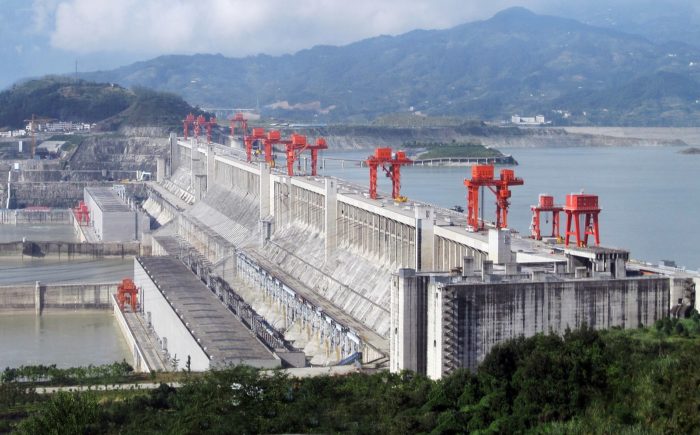For a few weeks now, we’ve had our eye on the Three Gorges Dam, a true feat of human engineering, and the largest hydroelectric dam in the world. The Three Gorges Dam generates 2% of China’s electricity, and that’s remarkable, but it’s not why we’ve been watching the dam. China has experienced a lot of rain lately. And even though it’s very hard to know what’s actually happening with the dam and what the risks are, folks have been worried about what all that rain could do.
First of all, if the dam were to break, a lot of people would die very quickly — within hours. Then, the resulting flood would devastate China. It would also have a significant impact on the rest of the world’s already-weakened supply chains.
So this is a risk that’s worth keeping an eye on and taking a few extra precautions for. Here are the highlights:
- Food prices and food security are already a problem as a result of the flooding in China. We’ll likely feel those ripple effects here.
- The actual collapse of the dam would devastate a critical part of many global supply chains, resulting in massive shortages of many categories of goods.
- There would also be a lot of financial market turmoil to navigate in the event of collapse.
- It’s very hard to gauge the current state of the dam, since information about it is tightly controlled.
- You should already be structuring your prepping in such a way that it takes into account ongoing supply chain disruptions and potential food price increases. But if you aren’t, then this issue adds extra urgency.
Impact on supply chains and the world’s economy
We don’t ring the alarm when just any river floods, or looks like it’ll flood. But the Three Gorges Dam isn’t situated in just any river. Some economists estimate that if the Yangtze River basin were its own country, it’d have the third-largest economy in the world. So if the dam breaks and the basin floods, the whole world would feel the impact.
China is responsible for manufacturing almost a third of the world’s products. More than half of that output happens in the Yangtze River Economic Basin, which would be flooded within a day if the Three Gorges Dam burst.
So if the Three Gorges Dam breaks, somewhere around 15% of the world’s manufacturing would stop.
In short, the river basin is key to the world’s economy. It’s central to manufacturing for companies like Apple, Walmart, and Nike — companies that have already seen supply chain issues due to COVID-19. Wuhan, originally the center of the coronavirus outbreak, is also located in the Yangtze basin.
We must first understand the importance of the Yangtze River in practical terms.
The watershed of the Yangtze is broadly divided into the Upper, Middle, and Lower Reaches.
Each reach is an industrial powerhouse, with specific economic and military significance.
9/
— HUNTSMAN (Charger 5) 🏴☠️ (@maphumanintent) July 27, 2020
A quick history of the Three Gorges Dam
The dam was built in 1994 and was intended to serve a few practical purposes:
- Generate electricity
- Speed economic growth
- Protect people from flooding
And like all great construction projects that countries invest in, it was, of course, meant to inspire national pride.
The Three Gorges Dam is a breathtaking structure. It is, according to NASA, “one of the few man-made structures so enormous that it’s actually visible to the naked eye from space.”
The problem is, the dam isn’t actually that good at handling the amount of water that can flow into it during really bad flooding. To prepare for the summer season of rain, the Three Gorges Dam slowly releases enough water to clear out 22 billion cubic meters of storage space. The problem is, during a really bad flood — the kind that’s supposed to happen once every hundred years — somewhere around 244 billion cubic meters of water can try to pass through the Three Gorges in a very short amount of time. So the 22 billion cubic meters of free space is eleven times too small.
In a vacuum, flooding isn’t a bad thing. Alluvial rivers flood with summer rains. That’s what they do. But a huge number of people live around the Yangtze River and downstream of the Three Gorges Dam.
The Three Gorges Dam works well in a normal year, but it has limits. The dam on its own can’t protect the Yangtze basin in a bad year. Some of the flooding China has seen this year, for instance, happened downstream of the dam. The dam is now holding back a huge amount of water from making that flooding worse. Xinhua Net reported last week that “reservoirs along the upper and middle reaches of Yangtze River, including the Three Gorges Dam and the Gezhou Dam, have held back over 30 billion cubic meters of floodwater since July this year.”
How likely is the dam’s collapse, really?
For the past two months, the Yangtze River basin has seen some significant rain. In fact, the area has had more rainfall this summer than it has in almost 60 years. The river has already started to overflow.
And it’s not that the people who live in the basin are sitting at home, worrying about what might happen. Already this summer, CNN says 54.8 million people have been impacted by flooding. Nearly 4 million people have lost housing, and 158 people have gone missing or died in the flooding.
Last week, Typhoon Hagupit made landfall in eastern China. This typhoon was the fourth to hit China in 2020, and meteorologists expect two or three more in the rest of August.
It’s hard to know exactly how likely a dam collapse is. It’s very hard to get good intel on the current state of the dam because it’s such a big deal to China. Information is very tightly controlled, and that means rumors fly around online all the time.
People speculate about collapse whenever there’s a bad flood season, in part because the dam is expected to hold back so much water. In July, this video circulated on social media showing just what a failure of the Three Gorges Dam would look like, and how far-reaching its effects would be:
https://youtu.be/J_KwViY2FAI?t=11
In July, pressure on the dam resulted in a “slight deformation in the structure,” the Guardian reported. Despite that damage, the dam has been officially declared safe. Still, aerial photographs of the dam have been limited in recent weeks, so it’s hard to know how the dam is doing and what exactly the risks are.
How to get ready, just in case
The bottom line — for months, now, it’s been challenging to get certain goods that come from China. At first, that was due to COVID-19 shutdowns, and now it’s due to supply chain issues. If the Yangtze basin sees more flooding this summer, or in a worst-case scenario, if the Three Gorges Dam collapses, those supply chain issues will only get worse.
If you haven’t already been stocking up on food, technology, medications, and other goods that involve China in some way, now is the time to start. That’s easier said than done, since companies make it as difficult as possible to figure out where products are made and what the supply chain looks like. But it’s safe to assume that most of the technology, apparel, and household products we consume involve China at some point in the supply chain.
If you order now, it still might take a while for your orders to arrive. But it’s better to place those orders now than it is to wait until it’s too late.
I guess my main points tho re: the dam are this: even before this you should have already been pretty worried about your ability to go into a store (or pharmacy) & get stuff that depends on China in some way. You should ALSO be worried enough re: food supplies to take precautions
— jonstokes.(eth|com) (@jonst0kes) July 27, 2020


You are reporting the comment """ by on